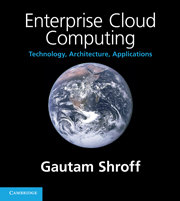Book contents
- Frontmatter
- Contents
- Preface
- List of abbreviations
- Part I Computing platforms
- Part II Cloud platforms
- Part III Cloud technologies
- Part IV Cloud development
- Part V Software architecture
- Chapter 13 Enterprise software: ERP, SCM, CRM
- Chapter 14 Custom enterprise applications and Dev 2.0
- Chapter 15 Workflow and business processes
- Chapter 16 Enterprise analytics and search
- Part VI Enterprise cloud computing
- References
- Index
Chapter 15 - Workflow and business processes
Published online by Cambridge University Press: 06 December 2010
- Frontmatter
- Contents
- Preface
- List of abbreviations
- Part I Computing platforms
- Part II Cloud platforms
- Part III Cloud technologies
- Part IV Cloud development
- Part V Software architecture
- Chapter 13 Enterprise software: ERP, SCM, CRM
- Chapter 14 Custom enterprise applications and Dev 2.0
- Chapter 15 Workflow and business processes
- Chapter 16 Enterprise analytics and search
- Part VI Enterprise cloud computing
- References
- Index
Summary
In the previous chapter we saw how basic forms-based transactions are assembled into an application. The resulting application resembles a ‘playground’ where each user can access available forms to create, modify or view data. In the process any business logic attached to the forms is also executed. In such a scenario, it is up to the user to decide what form to access and which transaction to perform. However, in real life users do not perform such tasks in a vacuum; rather they perform these tasks as part of an overall business process in which the user is participating. In this chapter we examine mechanisms by which an enterprise application can track such business processes and drive the ‘flow of work’ to users.
IMPLEMENTING WORKFLOW IN AN APPLICATION
We consider a simple ‘leave approval’ process. An employee places a leave request that goes to a supervisor. If approved it is forwarded to the HR department for their records; simultaneously the result, i.e. approval or rejection, is conveyed back to the employee. First let us design an application that implements this process, using a data model as shown in Figure 15.1. A LEAVEREQUEST table keeps track of the requests placed. The EMPLOYEE table captures each employee's supervisor as a self-referential foreign key. The application provides a New-Leave-Request form using which an employee can apply for leave.
- Type
- Chapter
- Information
- Enterprise Cloud ComputingTechnology, Architecture, Applications, pp. 203 - 216Publisher: Cambridge University PressPrint publication year: 2010



